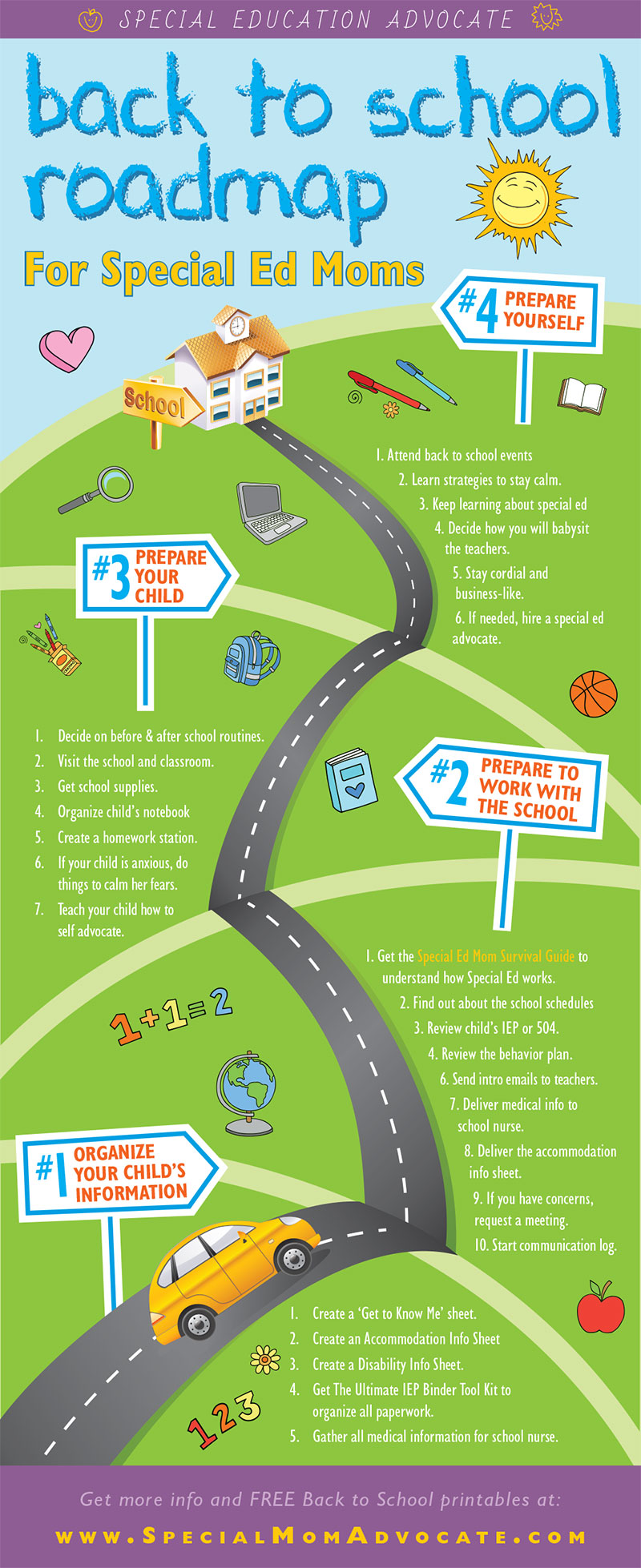 Unfortunately it is that time of year when we have to transition our kids away from a less structured schedule and extended sleep times to the reliability of the school day. Getting ready for back to school can be fun, but it can also be overwhelming when you have so much to do! I’ve created several Back to School resources to help you out.
Unfortunately it is that time of year when we have to transition our kids away from a less structured schedule and extended sleep times to the reliability of the school day. Getting ready for back to school can be fun, but it can also be overwhelming when you have so much to do! I’ve created several Back to School resources to help you out.
Here is a roadmap that helps you plan a course for getting started. It covers 4 areas of focus to make sure you don’t miss a beat. It also has a bunch of links to resources to help you get ready. With this handy tool, you’ll make sure everything gets done!
Here is the infographic. Below it are more details and links to free printable PDF downloads.
#1: Organize Your Child’s Information
- Create a ‘Get to Know Me’ sheet for your child.
- Create an Accommodation Info Sheet for your child.
- Create a Disability Info Sheet for your child.
- Organize all paperwork. Get The Ultimate IEP Binder Tool Kit to help you gain control of that paper mountain mess! Para obtener la carpeta del IEP en español, haga clic aquí.
- Gather all medical information that the school needs to know, such as medication prescription for at-school meds, allergy information, bee sting kit, etc. If you have a lot of medical paperwork, you can get my Special Needs Medical Records Notebook to help you get it organized.
#2: Prepare to work with the school
- Understand how special ed works and how to interact with the schools to get the best results. My book, Special Ed Mom Survival Guide, has step-by-step information on exactly how to do this.

- Understand why the schools say no by getting my very popular e-book, Why the School Can’t (or Won’t) Help Your Child.
- Find out about the school schedules (arrival, drop off, transportation). Make sure transportation is in place (if offered).
- Review child’s IEP or 504 to make sure everything is in place. If you don’t know some of the terms, check out this Special Education Acronym Infographic.
- Review your child’s IEP goals to know what he/she will work on this year. If you feel like your child needs more support, write up your concerns and request a meeting to discuss it. If you think the IEP Team is not doing a good job, then come up with a plan to improve the IEP.
- If you have an IEP meeting coming up, be sure to use the IEP Prep Checklist to be certain you’ve covered all your bases.
- Review the behavior plan (if you have one) and know what it entails. If you need behavior tracking in school, download my Behavior Support Sheets.
- Determine when your child’s IEP will be held so you will know if there are any meetings coming up.
- Send emails introducing yourself to the teacher(s) and IEP team. Send the Disability Info Sheet to the teacher(s) explaining your child’s disability and how it shows up at school.
- Delivery all medical paperwork to the school nurse.
- One week after school starts deliver the accommodation info sheet to the teachers so they know what accommodations your child is suppose to have.
- If you have concerns about the IEP or 504, request a meeting with the team.
- Start a communication log to track all emails, phone calls and letters.
#3: Prepare your child
- Decide on before and after school routine. Make sure you define how much screen time will be had each day, and when bedtime is supposed to happen.
- If the school is new for your child, visit the school and classroom.
- Get school supplies, including special supplies like pencil grips or fidgets.
- Organize child’s notebooks & folders
- Create a homework station in your home.
- Discuss the school day routine with your child so he is familiar with it. If need be, share some social stories to help them adjust.
- If your child is anxious about school, do things to calm her fears. Here are 60 books to help calm school fears in young children. If your child has issues staying calm, check out 12 Ways to Help Kids Calm Down. If your child has difficulty sitting still in class, you can also checkout my free printable, Calming the Hyper Child.
- Register for the Self-Advocacy for Special Ed Students online course and teach your child self-advocacy.
#4: Prepare yourself
- Attend start of the year events (Open House, Back-to-School night, etc.)
- Learn strategies to help you stay focused and calm. Breath! If you are anxious, read this blog I wrote about Back to School Jitters for Mom. If you feel overwhelmed by this process, be sure to build in time for self-care. Here is a free printable: 55 Self-Care Strategies for Moms With Too Little Time.
- Stay positive. Your child will pick up on it if you are nervous or frustrated.
- Keep learning about special education advocacy so you can advocate for your child. Here are 40 Special Education Social Media Accounts You Must Follow to stay up on current information.
- Decide how you will babysit the teachers so you know they are following through on providing special education services. You can volunteer, send monthly emails or find other ways to interact with teachers so you can keep an eye on things. Chapter 27 of my book is chock full of ideas on how to do this.
- Remember to stay cordial and business like. No matter what happened last year, start this year on a new footing.
- If you are concerned about your child’s special education, or not sure how to support your child, consider hiring a special education advocate to help.
Summary of all Resources in my Back to School Toolkit:
Tools:
- Special Ed Mom Survival Guide book
- IEP Cuaderno Para Padres en Español
- The Ultimate IEP Binder Tool Kit
- Special Needs Parent Medical Records Notebook
- Self-Advocacy for Special Ed Students online course
Printables:
- Back to School Checklist
- ‘Get to Know Me’ sheet
- Accommodation Info Sheet
- Disability Info Sheet
- IEP Preparation Checklist
- Calming the Hyper Child FREE
- 55 Self-Care Strategies for Moms With Too Little Time FREE
Infographics:
- Special Education Acronym
- The IEP Team is not doing a good job
- IEP or 504
- 12 Ways to Help Kids Calm Down
ABOUT THE AUTHOR:
Bonnie Landau is a professional counseling and holistic therapist in Ventura County, California. Her specialities include therapy for autism, therapy for ADHD, and therapy for parenting who have kids with autism or ADHD or other neurodivergence. She changed careers from graphic design to counseling with the goal of helping struggling parents of kids with ADHD, autism, or other neurodivergence find strategies and solutions to help their children succeed. Bonnie is also the author of Special Ed Mom Survival Guide: How to Prevail in the Special Education Process and Find Life-long Strategies for You and Your Child.





